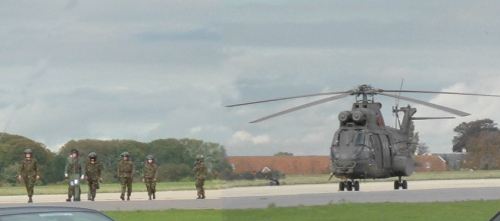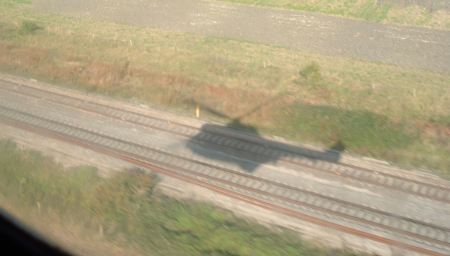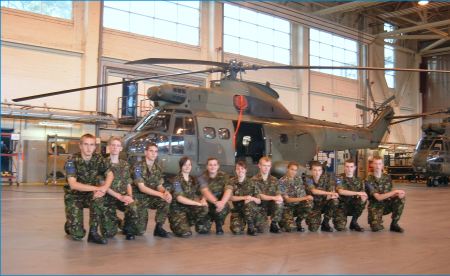|
134 (Bedford) Sqn Air Cadets |

|
| < 10th October 2006 - Hockey - Match Report | 15th October 2006 - Crowning Glory > |
Press Release |
134 (Bedford) Squadron |
14th October 2006
Artful Dodgers
Monday 9th of October 2006 proved extremely fruitful for 11 cadets and one member of staff from 134 (Bedford) Squadron as they participated in not one but two Puma helicopter training sorties with 33 Squadron at RAF Benson, Oxfordshire.

The day started with a not unusual early departure from the unit headquarters at Shortstown and proceeded to battle through rush hour traffic across four counties to one of the RAF’s two main operational helicopter bases in the UK. Upon arrival the group reported to the operations desk of 33 Sqn to a warm welcome by the duty SNCO who established which sorties the cadets had been assigned to. RAF Benson is home to two of the RAF’s busiest helicopter units, 33 Sqn, which is equipped with the Puma, and 28 Sqn, which operates the newer Merlin helicopter. Both units currently have aircraft deployed in Iraq and with 33 Sqn preparing to increase the number of assets there early next year the airfield was alive with aviation as crews begin their work up training.
Some of the Pumas are currently fitted with additional fuel tanks, which take up room in the cabin; this meant that the group couldn’t fly all at the same time. Instead the duty authoriser at 33 Sqn requested that the group be divided in two so that they could be flown on separate aircraft. With everyone safety briefed and issued with helmets that first group boarded their aircraft for a 10:30 lift. Cpl Bubbins takes up the story:

“Taking to the sky and departing from Benson we were treated with low level manoeuvres and tactical landings at different aerodromes around Oxfordshire, upon returning to base the pilot realised that we still had some time available so once again we moved out of the circuit and back to unrestricted airspace to carry out some aerobatic manoeuvres. After about and hour and a half we landed back at RAF Benson”.
Meanwhile in the crew room the second group were receiving a briefing on the route from their navigator. Reading the maps it was clear to the cadets that they were going to be flying in familiar territory as the route passed through Cambridgeshire and Bedfordshire. The Navigator looked into the possibility of over flying the squadron HQ but the permanent restriction over Cardington airship sheds put a dampener on that. None the less it looked set to be an exciting trip.
Out on the pan as the first group returned they boarded their aircraft in a hot change over, this is a full crew and passenger change over with the engines running and the rotors still turning, such is the intensity of training taking place that this saves the crews precious time. Soon after take off the pilot, navigator and loadmaster fully adopted the cadets as crew members and it was not long before cadet Soroko was up front in the jump seat giving the pilot instructions from the map. In the main cabin, and with both side doors fully open the cadets were treated to some spectacular low-level views.
The crew then gave sergeant Every a go at navigating, travelling at a mile a minute he soon discovered the workload placed upon the crew. Crucial decisions about route, height and looking out for objects such as built up areas and horse riders all became apparent. The sortie had three pre-determined targets that simulated different real life scenarios for the crew. These included troop deployment and extraction, observation and ground support. The most exciting of which began at another familiar location, DISC Chicksands, a tri-service station that 134 use for a number of activities acted as the initial point, the objective was to sneak up on a theoretical enemy located at the nearby Millbrook vehicle proving ground. Travelling at 100 knots and dipping to heights as low as 10 feet (3 meters) the crew used a shallow valley and ridge as cover, gradually working their way towards the target. However all is not straightforward when flying tactically, looming ahead was a major power line, climbing to fly over “the wires” would expose the aircraft to the enemy. Solution? Go underneath! With prior permission gained to go ahead with cadets on board the group were treated to a demonstration of utter professionalism as the crew worked as a closely knit team to pass beneath the obstruction.

Proceeding on we arrived over head Millbrook to surprised looks from the drivers of new Aston Martins being put through their paces. Having accomplished the three objectives the aircraft climbed to 2000 feet and set course for base, a route that had taken 2 hours that morning in a minibus was covered in 10 minutes.
On conclusion of the two Sorties AWO Browne made comment on the days events: “The experience that members of 134 gained today was immense, what is an everyday task for the crews of 33 Sqn will act as a source of inspiration and remain as memories for life amongst these cadets. I was privileged enough to be wired up on the intercom for the flight, the way in which the crew communicate and work together was a first rate demonstration of leadership and teamwork, something that we spend a lot of time imparting to our cadets. Low flying is always a contentious issue with the general public, it was fascinating to listen in and observe the efforts to which the crew go to minimise their impact on communities during a sortie, while at the same time still maintaining the level of preparation required for their future deployments. I would like to express my sincere thanks to all at RAF Benson and especially 33 Squadron for a very special opportunity and an insight into the RAF’s rotary operations”.
AWO Oliver Browne
See Also:
Video from this day in our video
library